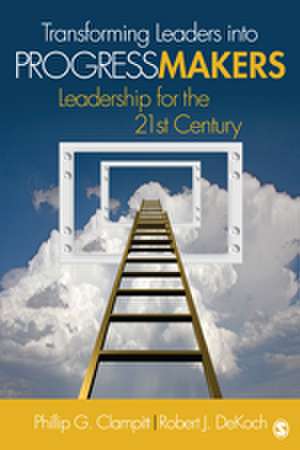Transforming Leaders Into Progress Makers: Leadership for the 21st Century
Autor Phillip G. Clampitt, Robert J. DeKochen Limba Engleză Hardback – 28 sep 2010
| Toate formatele și edițiile | Preț | Express |
|---|---|---|
| Paperback (1) | 552.97 lei 6-8 săpt. | |
| SAGE Publications – 28 sep 2010 | 552.97 lei 6-8 săpt. | |
| Hardback (1) | 842.37 lei 6-8 săpt. | |
| SAGE Publications – 28 sep 2010 | 842.37 lei 6-8 săpt. |
Preț: 842.37 lei
Preț vechi: 1027.29 lei
-18% Nou
161.24€ • 175.20$ • 135.53£
Carte tipărită la comandă
Livrare economică 21 aprilie-05 mai
Specificații
ISBN-10: 1412974682
Pagini: 280
Dimensiuni: 152 x 229 x 15 mm
Greutate: 0.45 kg
Ediția:First Edition
Editura: SAGE Publications
Colecția Sage Publications, Inc
Locul publicării:Thousand Oaks, United States
Recenzii
This book contains concepts and insights that advance the study and practice of leadership. It is to be celebrated equally for its humility as well as its assertions. Here there are no false claims of certainty demonstrating that the authors practice what they preach. Instead of punctuating their work with a declarative statement of truth they enjoin the reader to refine and explore. The authors are in search of a more sustainable form of leadership, a project that could be the next great platform of leadership theory.
"The book is filled with rich and diverse business examples that challenge the reader to re-evaluate long-held "truths" about how to move an organization ahead, in spite of inevitable roadblocks along the way."
"Clampitt and DeKoch enhance the reader's understanding of their model by providing compelling examples of leaders who have transformed their organizations into highly effective, successful organizations; true Progress Makers."
"Underpinning their theory are practical tools to help leaders make the right day-to day choices and transform themselves into true "Progress Makers." This is a must-read for navigating these extremely uncertain times and moving your company forward."
Cuprins
1. Introduction
Our Purpose
Our Approach
2. Exploring
Attributes of Explorers
Exploring and Progress Making
Concluding Thoughts
3. Refining
Attributes of Refiners
Refining and Progress making
Concluding Thoughts
4. Platforms
How Platforms Emerge
Features of Platforms
Concluding Thoughts
5. Progress
Defining Progress
Implications of the Progress Definition
Concluding Thoughts
Progress Maker Profile: Oscar Boldt and The Boldt Company
6. The Progress Model
How the Progress Model Works
So What?
Concluding Thoughts
7. How Explorers and Refiners Make Progress
The Explorers Mode of Making Progress
The Refiners Mode of Making Progress
The Challenges Faced by Explorers and Refiners
Concluding Thoughts
8. Progress Makers
The Central Conundrum
The Progress Maker’s Response
Making the Right Choices
Progress Maker Profile: Ron Reed and the Discovery Channel
SECTION TWO
9. Envision the Future with Calculated Boldness
Defining the Concept
What Inhibits Calculated Boldness
What to Do?
Concluding Thoughts
Progress Maker Profile: Brigadier General H.R. McMaster
10. Cultivate a Focused Flexibility Mindset
A Deeper Look at Focus and Flexibility
Why is Focused Flexibility so Difficult?
What to Do?
Concluding Thoughts
11. Enlarge the Circle of Engagement
The Concept
Why Don’t We Enlarge the Circle?
How do You Enlarge the Circle of Engagement?
Concluding Thoughts
Progress Maker Profile: Vicki Wilson and Door County Coffee & Tea
12. Foster the Growth of Investment-Worthy Employees
Defining the Concept
Barriers
What to Do?
Concluding Thoughts
13. Seek, Nurture and Evaluate Actionable Ideas
Defining the Concept
Phases to Generate Actionable Ideas
Barriers
What to Do?
Concluding Thoughts
Progress Maker Profile: Laura Hollingsworth and The Des Moines Register & Gannett
14. Select, Detect, and Correct the Proper Errors
Background
Error Management Framework
The Counter Forces
What to Do?
Concluding Thoughts
15. Practice Receiver-Centric, Strategy-Based, Feedback-Driven Communication
Defining the Concept
Barriers
What to Do?
Concluding Thoughts
16. Conclusion
Appendix 1: Progress Makers
Appendix 2: UMM and the Origins of Focused Flexibility
Index
About the Authors
Notă biografică
Phillip G. Clampitt received his Ph.D. in organizational communication from the University of Kansas. He holds the Blair Endowed Chair of Communication and was previously the Hendrickson Professor of Business at the University of Wisconsin-Green Bay where he is a full professor. Dr. Clampitt is the chair of four units at UWGB: Information & Computing Science, Communication, Computer Science, and Information Science. Sage Publications recently published the sixth edition of his best-selling book, Communicating for Managerial Effectiveness 6e. He co-authored two books with Robert J. DeKoch (President/COO of the Boldt Company): Embracing Uncertainty: The Essence of Leadership and Transforming Leaders into Progress Makers.
Phil¿s work on ¿Decision Downloading¿ was featured in the MIT Sloan Management Review and the Wall Street Journal. Additionally, he has published in numerous journals, including The Academy of Management Executive, Journal of Communication Management, Journal of Business Communication and Management Communication Quarterly. He has contributed chapters to numerous works including: Handbook of Communication Audits for Organisations, Communication Audits, and the International Encyclopedia of Organizational Communication. He also is on the editorial board of many professional journals. Over the past thirty years he has worked on communication and leadership issues with many organizations including Nokia, PepsiCo, Schneider National, The Boldt Company, Dental City, National University and the Menasha Corporation.
Phil has been a guest speaker at the U.S. Army War College where they use his books in their Strategic Leadership class. In addition to many guest-speaking opportunities in the U.S., he has also been invited to speak internationally at places such as The University of Pisa, The University of Aberdeen, The University of Ulster, as well as to numerous multi-national businesses and professional organizations.
His students have heard him ask, "So what?" so often that they started calling him ¿Dr. So What.¿ Subsequently, he developed a related website (www.drsowhat.com) that highlights his passionate commitment to critical thinking and thoughtful inquiry.













